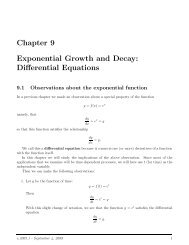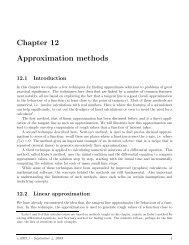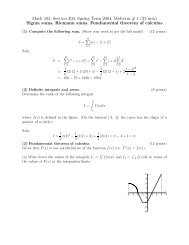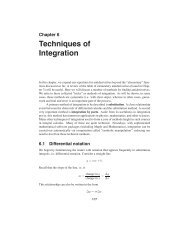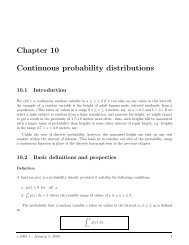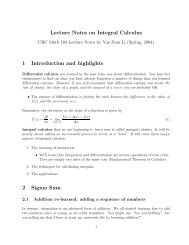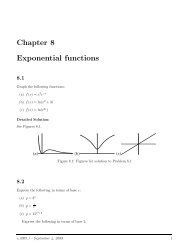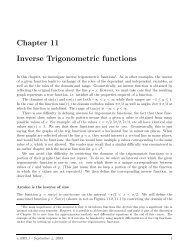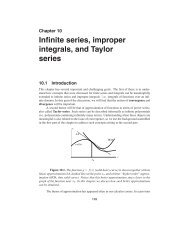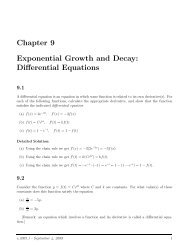Chapter 10 Trigonometric functions - Ugrad.math.ubc.ca
Chapter 10 Trigonometric functions - Ugrad.math.ubc.ca
Chapter 10 Trigonometric functions - Ugrad.math.ubc.ca
You also want an ePaper? Increase the reach of your titles
YUMPU automatically turns print PDFs into web optimized ePapers that Google loves.
Math <strong>10</strong>2 Notes <strong>Chapter</strong> <strong>10</strong><br />
θ<br />
s<br />
Figure <strong>10</strong>.1: The angle θ in radians is related in a simple way to the radius R of the circle, and the<br />
length of the arc S shown.<br />
From Figure <strong>10</strong>.1 we see that there is a correspondence between the angle (θ) subtended in a<br />
circle of given radius and the length of arc along the edge of the circle. For a circle of radius R and<br />
angle θ we will define the arclength, S by the relation<br />
S = Rθ<br />
where θ is measured in a convenient unit that we will now select. We now consider a circle of radius<br />
R = 1 (<strong>ca</strong>lled a unit circle) and denote by s a length of arc around the perimeter of this unit circle.<br />
In this <strong>ca</strong>se, the arc length is<br />
S = Rθ = θ<br />
We note that when S = 2π, the arc consists of the entire perimeter of the circle. This leads us to<br />
define the unit <strong>ca</strong>lled a radian: we will identify an angle of 2π radians with one complete revolution<br />
around the circle. In other words, we use the length of the arc in the unit circle to assign a numeri<strong>ca</strong>l<br />
value to the angle that it subtends.<br />
We <strong>ca</strong>n now use this choice of unit for angles to assign values to any fraction of a revolution,<br />
and thus, to any angle. For example, an angle of 90 ◦ corresponds to one quarter of a revolution<br />
around the perimeter of a unit circle, so we identify the angle π/2 radians with it. One degree is<br />
1/360 of a revolution, corresponding to 2π/360 radians, and so on.<br />
To summarize our choice of units we have the following two points:<br />
1. The length of an arc along the perimeter of a circle of radius R subtended by an<br />
angle θ is S = Rθ where θ is measured in radians.<br />
2. One complete revolution, or one full cycle corresponds to an angle of 2π radians<br />
It is easy to convert between degrees and radians if we remember that 360 ◦ corresponds to 2π<br />
radians. For example, 180 ◦ then corresponds to π radians, 90 ◦ to π/2 radians, etc.<br />
v.2005.1 - September 4, 2009 2



